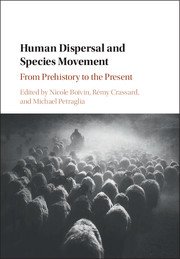Book contents
- Frontmatter
- Contents
- List of text boxes
- List of figures
- List of tables
- List of contributors
- Preface
- I Introduction
- II Origins: Species Movements in the Pleistocene
- III Across the water: Species movements by Coast and Sea
- IV Complexity: Species Movements in the Holocene
- V Invasion: The Movement of Invasive and Disease Species
- 15 Invasive eusocieties: Commonalities between ants and humans
- 16 Invasives, aliens, and labels long forgotten: Toward a semiotics of human-mediated species movement
- 17 Multiple time scales for dispersals of bacterial disease over human history
- 18 Early malarial infections and the first epidemiological transition
- 19 The globalisations of disease
- 20 Modern day population, pathogen and pest dispersals
- Index
- Plate section
- References
15 - Invasive eusocieties: Commonalities between ants and humans
from V - Invasion: The Movement of Invasive and Disease Species
Published online by Cambridge University Press: 04 May 2017
- Frontmatter
- Contents
- List of text boxes
- List of figures
- List of tables
- List of contributors
- Preface
- I Introduction
- II Origins: Species Movements in the Pleistocene
- III Across the water: Species movements by Coast and Sea
- IV Complexity: Species Movements in the Holocene
- V Invasion: The Movement of Invasive and Disease Species
- 15 Invasive eusocieties: Commonalities between ants and humans
- 16 Invasives, aliens, and labels long forgotten: Toward a semiotics of human-mediated species movement
- 17 Multiple time scales for dispersals of bacterial disease over human history
- 18 Early malarial infections and the first epidemiological transition
- 19 The globalisations of disease
- 20 Modern day population, pathogen and pest dispersals
- Index
- Plate section
- References
Summary
Abstract
Similar to humans, ants dominate many terrestrial ecosystems as a result of their absolute numbers and diversity. Ants build cities, conduct wars, maintain infant nurseries and cemeteries, and practice agriculture and husbandry. In contrast to humans, the extraordinary ecological success of ants, and their propensity to invasion, has been achieved without the evolution of higher individual cognitive abilities. In this chapter, I describe the qualities that enhance ant dispersal and explore comparisons between ants and humans in the context of the colonization of new environments. Ants and humans have several characteristics in common that have facilitated their global dispersal and ecological success: cooperation, sociality, advanced communication, division of labour, and a generalist lifestyle. Ant societies and human societies are the result of two major transitions in the evolution of complexity in life. Progress in understanding one evolutionary transition might help to explain others.
Keywords: Ants, cooperation, dispersal strategies, invasiveness, unicoloniality
INTRODUCTION: THE ECOLOGICAL SUCCESS OF SOCIETIES
Around 2 million years ago, hominins dispersed out of Africa and started a complex and dynamic process of colonization of the planet, which ultimately culminated in the globalized occurrence of Homo sapiens. The reasons and conditions for this spectacular ecological success are multiple and they are extensively discussed in this volume (see in particular chapters in this volume by Dennell, Drake and Blench, Erlandson, and Petraglia). Above all, it appears that increasing technological innovation, and the parallel development of underlying advanced cognitive abilities, significantly contributed to global human dispersal and anthropogenic ecosystem management. Evidence points to the likelihood that these levels of increasing cognitive complexity would have not been reached if hominins were a solitary species; instead, it appears that brain development is linked to increased group size (Dunbar 2003), multifaceted social interactions (Dunbar et al. 2010), and the characteristics of social networks (see Dennell, this volume).
Here, I will introduce the habits of a group of animals in which, in contrast to humans, extraordinary ecological success and a propensity for invasion have been achieved in the absence of the evolution of higher cognitive abilities, at least at the individual level. Yet, as with humans, the key to the globalized success of these species appears to be related to a highly structured social life.
- Type
- Chapter
- Information
- Human Dispersal and Species MovementFrom Prehistory to the Present, pp. 411 - 429Publisher: Cambridge University PressPrint publication year: 2017



